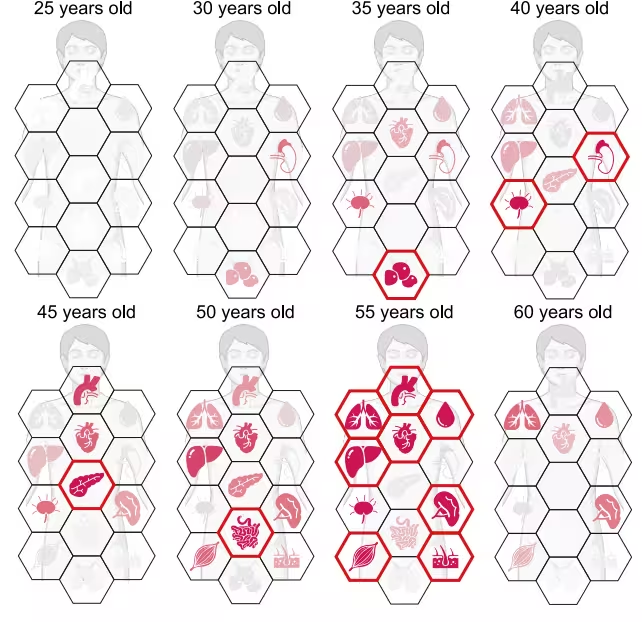5 Minutes
Understanding the Nonlinear Nature of Human Aging
Aging is a universal biological process, but recent research is challenging the idea that it unfolds at a steady pace. Unlike the predictable march of time, the evolution of human aging is marked by distinct phases—periods of rapid development, stability, and, as new evidence suggests, abrupt acceleration in later years. According to a groundbreaking study led by researchers from the Chinese Academy of Sciences, age 50 emerges as a major turning point when the speed of aging in organs and tissues sharply increases.
Proteomic Insights Reveal Aging’s Inflection Point
In their in-depth investigation, scientists analyzed protein changes—a field known as proteomics—across various organs from 76 human donors aged 14 to 68. By tracking shifts in thousands of proteins across seven key physiological systems (including the cardiovascular, digestive, immune, endocrine, respiratory, integumentary, and musculoskeletal systems), they identified how distinct tissues age over time. The researchers also included blood analysis to gain a comprehensive view of systemic aging.
The results point to a striking pattern: between ages 45 and 55, particularly around 50, several organs undergo pronounced molecular changes. This period marks a significant acceleration of aging, especially within the cardiovascular system. Blood vessels, and the aorta in particular, were found to age more rapidly than other tissues, rendering them highly susceptible to age-related degeneration. The pancreas and spleen also exhibited notable, continued age-driven changes.
Linking Protein Changes and Disease Risk
To understand how these protein shifts impact health, the team cross-referenced their findings with databases linking proteins to diseases and genetic risk factors. They discovered that 48 age-elevated proteins are tied to conditions such as cardiovascular diseases, tissue fibrosis, nonalcoholic fatty liver disease, and various liver tumors. This highlights how the molecular aging of organs translates into higher risk for age-associated chronic illnesses as people grow older.
Experimental Validation: The Aorta’s Role in Aging
To confirm the detrimental effects of accelerated vascular aging, the researchers isolated a protein upregulated with age in mouse aortas and injected it into young mice. The treated mice soon exhibited signs of vascular aging, such as diminished grip strength, endurance, balance, and coordination—hallmarks of physical decline. Moreover, these animals showed clear biological markers of vascular aging, supporting the idea that specific protein alterations play a direct role in aging’s functional consequences.

Mapping the Unique Complexity of Human Aging
Earlier studies have suggested that the process of aging isn’t uniform. Other research revealed additional age-related peaks at around 44 and 60, indicating that aging advances in a step-wise, system-dependent manner rather than as a simple, gradual process. The new evidence underscores the importance of mapping proteomic and organ-specific aging trajectories to understand how each body system is affected differently over time.
As the study authors explain, constructing a comprehensive multi-tissue proteomic atlas spanning the lifespan can illuminate the mechanisms that disrupt protein equilibrium—a state known as proteostasis—in aging organs. It can also help to identify universal versus tissue-specific markers and vulnerabilities, laying the groundwork for interventions to slow or modify age-associated degeneration.
Broader Implications and Future Prospects
The ability to detect a precise inflection point in biological aging opens promising opportunities for targeted medical interventions. By identifying when and where tissues are most vulnerable, researchers and clinicians can develop strategies to prevent or mitigate age-related diseases, ultimately aiming to extend both lifespan and healthspan—the years of life spent in good health. Such research also propels the field closer to personalized medicine approaches, in which therapies can be customized based on an individual's unique aging trajectory.
The findings signal a new era in longevity science, one where the molecular landscape of aging is mapped in detail, enabling earlier detection of risk and more effective treatment options for age-associated conditions.
Conclusion
This pioneering study convincingly demonstrates that age 50 marks a pivotal period where human aging accelerates at the molecular and organ level, especially in blood vessels and other critical tissues. By advancing our understanding of the proteomic underpinnings of aging, scientists are paving the way for innovative therapies aimed at maintaining organ function, preventing chronic disease, and improving quality of life for adults worldwide. As this research expands, it holds promise not only for extending longevity but also for enriching the health and vitality of future generations.
Source: cell


Leave a Comment